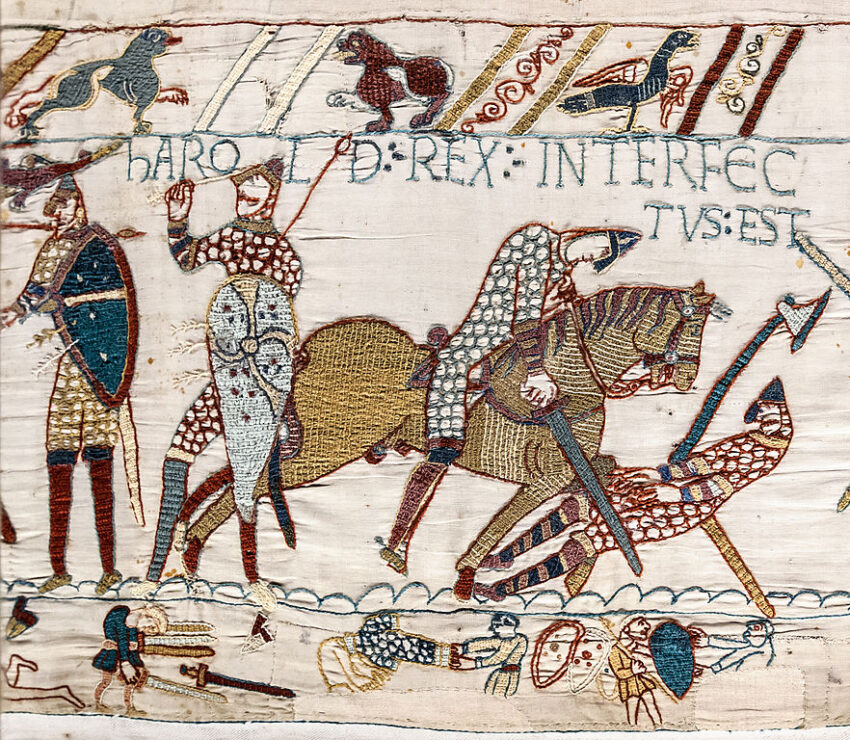The Battle of Hastings Quiz Questions
1. In what year did the Battle of Hastings take place?
(a) 966
(b) 1066
(c) 1166
(d) 1266
2. Who was the English king who died , sparking the conflict?
(a) Richard the Lionheart
(b) Edward the Confessor
(c) William the Conqueror
(d) Alfred the Great
3. Which Duke of Normandy invaded England and claimed the throne?
(a) Duke Richard I
(b) Duke William
(c) Duke Godfrey
(d) Duke Rollo
4. What was the nickname William of Normandy received after his victory?
(a) William the Gentle
(b) William the Pious
(c) William the York
(d) William the Conqueror
5. Where did the Battle of Hastings take place?
(a) London
(b) York
(c) Hastings
(d) Dover
6. What was the main weapon used by the English army?
(a) Longbows
(b) Cannons
(c) Swords
(d) Pikes
7. What tactic did the English use to defend their position?
(a) Cavalry charges
(b) Shield wall formation
(c) Guerilla warfare
(d) Naval attacks
8. What advantage did the Norman army have in terms of weaponry?
(a) Superior armor
(b) Stronger horses
(c) More longbowmen
(d) Larger shields
9. How did the death of King Harold II during the battle affect the English forces?
(a) It had little impact.
(b) It demoralized and weakened them.
(c) It inspired them to fight harder.
(d) It led to a strategic retreat.
10. What was the long-term consequence of the Norman victory?
(a) A Viking invasion of England
(b) The Norman Conquest of England
(c) A Scottish rebellion
(d) A peasant uprising
11. Which language did the Norman invasion significantly influence?
(a) Welsh
(b) Gaelic
(c) Old English
(d) Latin
12. What event is traditionally considered the end of the Anglo-Saxon period in England?
(a) The Viking raids
(b) The Battle of Hastings
(c) The Norman Conquest
(d) The Hundred Years’ War
13. Which pope initially opposed William’s claim to the English throne?
(a) Pope Urban II
(b) Pope Gregory VII
(c) Pope Innocent III
(d) Pope Clement VII
14. How did William the Conqueror appease the English nobility after his victory?
(a) He executed them all.
(b) He offered them land and titles.
(c) He forced them to convert to Catholicism.
(d) He exiled them from England.
15. What was the role of archers in the Norman army?
(a) The main fighting force
(b) Cavalry support
(c) Shield wall defenders
(d) Siege weapon operators
16. Which language was most commonly spoken by the Norman invaders?
(a) English
(b) French
(c) Latin
(d) Norse
17. What famous landmark was built by William the Conqueror shortly after the battle?
(a) Stonehenge
(b) Tower of London
(c) Hadrian’s Wall
(d) Buckingham Palace
18. What social system was introduced to England after the conquest?
(a) Feudalism
(b) Democracy
(c) Monarchy
(d) Republic
19. What was the name of the hill where the English army made its stand during the battle?
(a) Breed’s Hill
(b) Hadrian’s Wall
(c) Dover Cliffs
(d) Stonehenge
20. William of Normandy’s claim to the throne was based on what?
(a) He was the strongest Saxon lord.
(b) He was promised the crown by Edward the Confessor.
(c) He had defeated the Vikings in a major battle.
(d) He was the rightful heir through blood relations.
21. What type of army did William of Normandy lead?
(a) Primarily Saxon infantry
(b) A mix of Norman knights, archers, and foot soldiers
(c) A large Viking force
(d) Mostly Scottish mercenaries
22. The English army positioned themselves on what kind of terrain?
(a) Open field
(b) Dense forest
(c) Mountainous region
(d) Swampy lowlands
23. What was William’s famous military tactic during the battle?
(a) A flanking maneuver
(b) A full frontal assault
(c) A surprise night attack
(d) Using psychological warfare
24. What happened to King Harold II during the battle?
(a) He was captured and imprisoned.
(b) He successfully retreated with his army.
(c) He died on the battlefield.
(d) He negotiated a truce with William.
25. What architectural style did the Normans introduce to England?
(a) Gothic
(b) Romanesque
(c) Saxon
(d) Byzantine
The Battle of Hastings Quiz Questions with Answers
1. In what year did the Battle of Hastings take place?
(b) 1066
2. Who was the English king who died , sparking the conflict?
(b) Edward the Confessor
3. Which Duke of Normandy invaded England and claimed the throne?
(b) Duke William
4. What was the nickname William of Normandy received after his victory?
(d) William the Conqueror
5. Where did the Battle of Hastings take place?
(c) Hastings
6. What was the main weapon used by the English army?
(a) Longbows
7. What tactic did the English use to defend their position?
(b) Shield wall formation
8. What advantage did the Norman army have in terms of weaponry?
(a) Superior armor
9. How did the death of King Harold II during the battle affect the English forces?
(b) It demoralized and weakened them.
10. What was the long-term consequence of the Norman victory?
(b) The Norman Conquest of England
11. Which language did the Norman invasion significantly influence?
(c) Old English
12. What event is traditionally considered the end of the Anglo-Saxon period in England?
(c) The Norman Conquest
13. Which pope initially opposed William’s claim to the English throne?
(b) Pope Gregory VII
14. How did William the Conqueror appease the English nobility after his victory?
(b) He offered them land and titles.
15. What was the role of archers in the Norman army?
(a) The main fighting force
16. Which language was most commonly spoken by the Norman invaders?
(b) French
17. What famous landmark was built by William the Conqueror shortly after the battle?
(b) Tower of London
18. What social system was introduced to England after the conquest?
(a) Feudalism
19. What was the name of the hill where the English army made its stand during the battle?
(a) Breed’s Hill
20. William of Normandy’s claim to the throne was based on what?
(b) He was promised the crown by Edward the Confessor.
21. What type of army did William of Normandy lead?
(b) A mix of Norman knights, archers, and foot soldiers
22. The English army positioned themselves on what kind of terrain?
(a) Open field
23. What was William’s famous military tactic during the battle?
(b) A full frontal assault
24. What happened to King Harold II during the battle?
(c) He died on the battlefield.
25. What architectural style did the Normans introduce to England?
(a) Gothic




